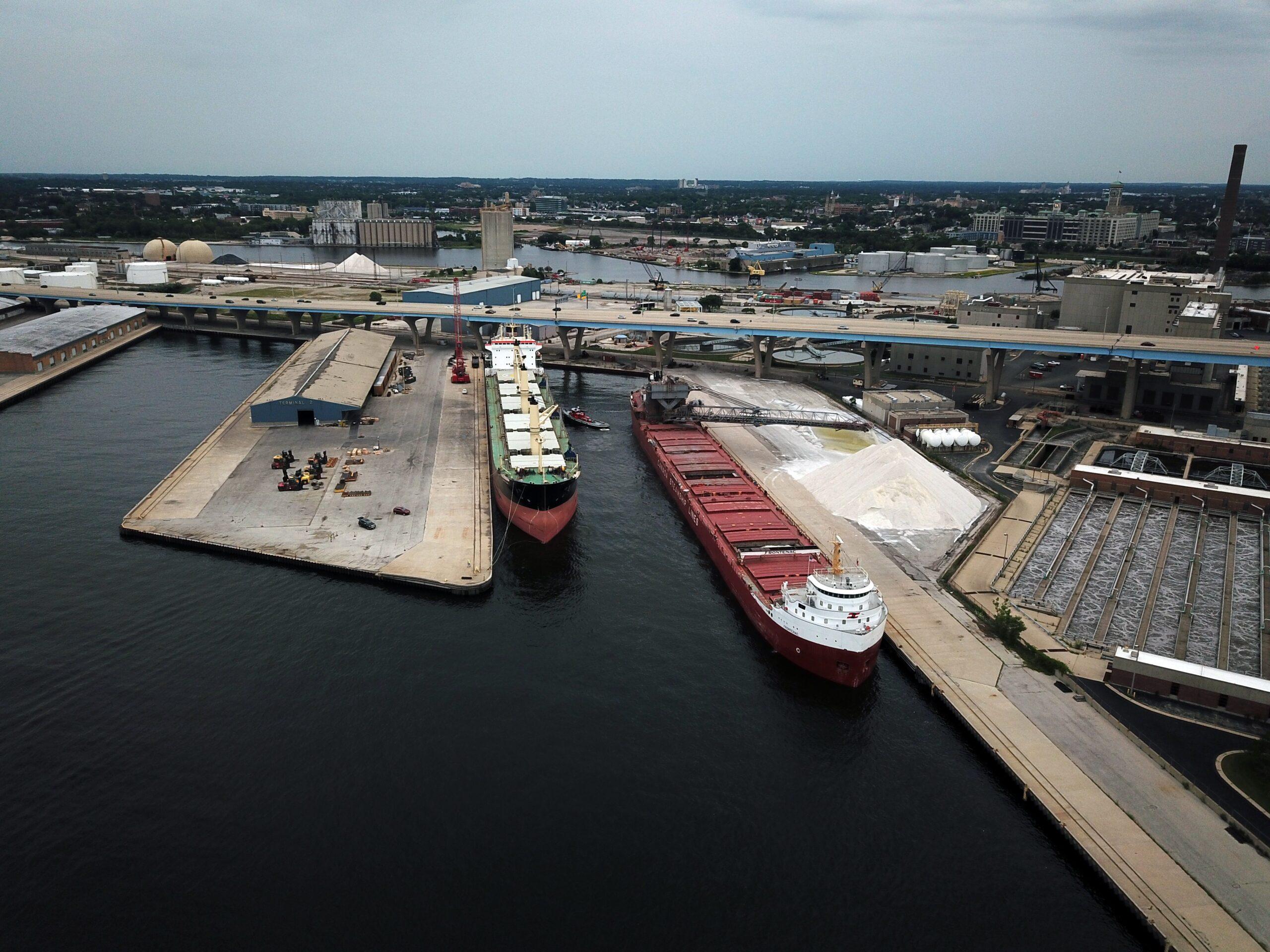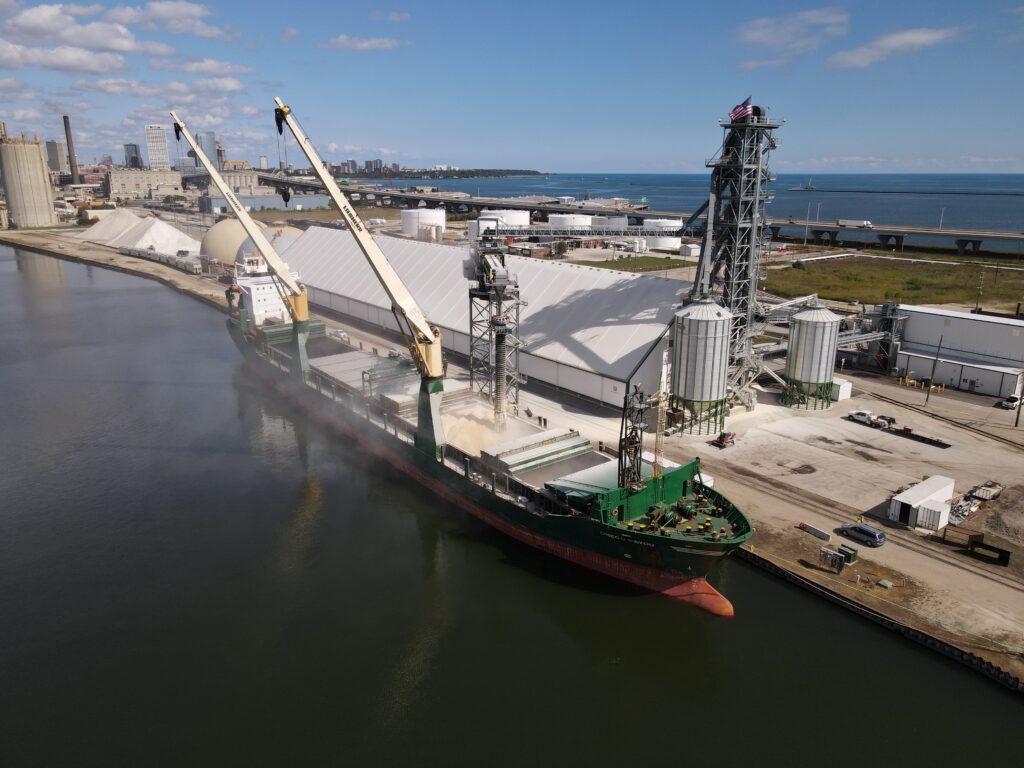
A new $40-million agricultural maritime export facility – the largest one-time investment in Port Milwaukee in some 70 years – will further position the port as an essential multimodal and marine transportation hub in the heartland of North America.
Operated by Clinton, Wisconsin-based The DeLong Co., Inc., the terminal is expected to increase exports through Port Milwaukee by as much as 400,000 tons per year and connect Wisconsin farmers, growers and producers with new international markets. The facility is among the first on the Great Lakes-St. Lawrence Seaway system that can handle a variety of agricultural commodities by truck, rail and international vessels.
The terminal currently moves dried distillers grains with solubles, an animal feed supplement high in nutrients derived as a byproduct of ethanol, but future service may include the export of Wisconsin grown soybeans, corn and grain, allowing the state’s maritime and agricultural economies to expand beyond Asia and into other international markets such Northern Europe, Northern Africa and the Mediterranean. The two vessels that called at the facility last year sailed to Ireland.
The Wisconsin Department of Transportation estimates the terminal will generate $63 million in new statewide economic impact annually. “This new facility will have a tremendous impact here in the local Milwaukee community and around the state and will help ensure more of our farmers’ best-in-class, Wisconsin-made goods will be shared with folks all over the world,” said Governor Tony Evers at the opening of the terminal last July.
“It’s a very impressive facility. We are pretty happy with it,” said Port Director Jackie Q. Carter. “We also are excited about the fact that not only is the facility up and operational, but we are already looking to expand its footprint just based on the feedback we have received from growers and producers in the region.”
The Maritime Administration announced in November a Port Infrastructure Development Program grant of $9.3 million for Phase 2 of the terminal.
“It was really important to us to immediately expand the capacity of The DeLong facility so that they can handle more commodities at once,” Ms. Carter said. “Ideally, we’d love to see the expansion come by harvest 2024, but we’ve got to get a lot of the agreements in place and make sure we’re in compliance with the grant requirements.”
Port Milwaukee handles a wide variety of cargo including agricultural exports, cement, construction material, salt, limestone, steel and other general cargo. Total traffic reached 2.36 million metric tons in 2023, up nearly 4% from 2.27 million metric tons the previous year. Total dry bulk volumes increased by 20%, with salt (up 7.5%), cement (up 8%) and aggregates (up 194%) leading the way. Liquid bulk volumes increased by 25% in 2023 compared with the previous year.
The port also handles high-value breakbulk and project cargo. In the past couple of years, it has moved brewery tanks, large dryer pieces used in the paper-making process, and even superyacht pieces.
“We are looking at project cargoes, the diverse cargoes that we don’t typically see,” Ms. Carter said. “We are looking to see if there’s an avenue to grow that part of our business. I think we do really well with our bulk commodities, but it’s those one-offs and those unique cargoes that we want to make sure people understand that we have a service here and we can meet that need. That’s going to be a big effort for us in 2024.”

Cruising has become another important part of the port’s business. “We had a really solid cruise season with 30 vessel visits (in 2023),” Ms. Carter said. Viking Cruises’ Viking Polaris and Hapag-Lloyd Cruises’ Hanseatic Inspiration called at Milwaukee for the first time last year. A total of 11,502 passengers visited the city.
“The cruise ships have really elevated our community profile, and so residents are more aware of our existence as a port than they’ve ever been, all because they are fascinated by the fact that cruise ships dock in Milwaukee, right here in their city,” Ms. Carter said.
The port uses the downtown Pier Wisconsin for smaller cruise ships. “It’s a great entrance to the city and a great view for the passengers coming in,” Ms. Carter said. Larger ships use the port’s City Heavy Lift Dock. The port is working with its partners to build outside of its commercial shipping area a dock – the South Shore Cruise Dock – for larger vessels so that it can host multiple cruise ships simultaneously.
“We want to get the cruise vessels into a nicer location that is specific for cruising,” Ms. Carter said. Construction could begin this year.
Port Milwaukee continuously trumpets the cruise business in Milwaukee and throughout the Great Lakes. It is the founder of the Milwaukee Cruise Collaborative, a local group promoting the city as a cruise destination. The Collaborative includes a cross section of the local hospitality industry.
“As a port, our first business is commercial operations and moving commercial cargo,” Ms. Carter said. “I always kind of joke that when you have cruise ships, and your cargo becomes people with opinions who move and don’t stay where you put them, you’ve really got to be strategic about it. You need to lean on people who are in
the tourism industry, who know how to handle visitors and understand what they’re looking for, and help us to ensure that the passengers have a really good experience when they come to Milwaukee.”
Visit Milwaukee, the GLS, other Great Lakes ports and vessel agents are among the port’s most important cruise partners. “We’ve got a great shore excursion operator, Great Lakes Shore Excursions, which plans all kinds of events and coordinates with the cruise ship to make sure that the passengers have the information and the activities they want and need,” Ms. Carter said. “We really appreciate the work they do and the support they provide to make sure that the cruise companies are happy with the experience that their passengers are receiving because we want to make sure they keep coming back.
“Our state has talked about how the tourism industry has grown and the increase in economic impact we have seen, and cruise ships in Milwaukee have a good hand in that.”
Jackie Carter celebrated in February (2024) her one-year anniversary as port director. She took the helm from Adam Tindall-Schlicht, who was appointed Administrator of the GLS. Ms. Carter is the first woman, and the first person of colour, to serve as Director of Port Milwaukee. She was previously the port’s Finance and Administration Officer, where she provided oversight of all port business operations, including its financial, human resource and administrative functions, and was integral in helping to shape the department’s strategic planning and grant funding efforts.

“I think one of the things for me personally as the new director was getting in front of every tenant that is on port property to better understand their business, how they operate and who they serve so that we can better support everything that they do,” Ms. Carter said.
“One of the things that I’m really looking to do is strengthen our ability to support and do business development. We call it a kind of reverse port 101, because we do port 101 where we bring folks in and tell them all the things about the port. Now, it’s us going to these businesses and allowing them to tell us their stories so that we can better tell them when we’re out at industry events and networking with people who are talking about what they need. We can be thinking about what port tenants exist at Port Milwaukee that might be able to meet those needs.
“We really want to be partners with our tenants in their business because when they do well, so do we. It’s in our best interests to support them as best we can. In order to do that and be effective at that, we really want to understand, ‘Who’s your ideal customer? When we’re on the road and you’re not there, who should we be saying your
name to?’ That’s really what this effort is all about.”
Ms. Carter credits the 21-person staff at Port Milwaukee and the businesses on port property for the port’s success. “It’s a great team,” she said. “There’s a lot of collaboration, and that’s really how we get stuff done. In 2024, we want to keep the momentum going, and look for new ways, new avenues we can pursue to attract some business that we haven’t seen in recent years.”